
Riding rules, signs and safety tips

Find information on riding rules, signs and safety tips to ride safely in Brisbane.
Riding rules
Riding on bikeways and shared paths
Brisbane City Council installs signs to help people walking, people riding a bike and people using e-mobility devices or personal mobility devices) understand the rules when using Brisbane's bikeways and shared pathways. Unless otherwise signed, the following can use bikeways, shared paths and footpaths:
- people riding bikes and e-bikes
- people walking
- people riding skateboards, foot scooters and roller blades (wheeled recreational devices)
- people riding personal mobility devices such as electric scooters or electric skateboards
From 1 November 2022, the Queensland Government has introduced new legislation that changes how different personal mobility devices can use different types of paths and roads. This change affects how people will use many of Council’s popular shared pathways and footpaths.
Visit the Queensland Government website to find out what road rules apply for:
- bike riders and e-bike riders
- personal mobility devices (e.g. e-scooters)
- skateboards and foot (non-powered) scooters.
As part of the new laws, the Queensland Government has created the option for local councils to apply for increased speed limits on shared pathways of up to 25km/h in certain locations that meet key safety guidelines. Once Council has reviewed the guidelines, it will assess which shared pathways would be safe and suitable for increased speed limits.
Types of pathways
There are three different types of paths for people walking, riding a bike, using a personal mobility device or a wheeled recreational device.
Footpaths can be used by everyone, however personal mobility devices and signed restrictions may apply in certain areas. People walking have right of way and other footpath users are required to give way to people walking at all times.
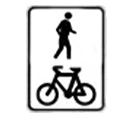
Shared pathway
- Keep left.
- People walking are not to block the path.
- Bike, wheeled recreational devices and personal mobile device riders give way to people walking.
- Bike and personal mobility device riders should slow down and notify the person walking that they are approaching.
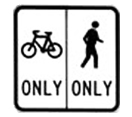
Separated pathway
- One side is for bike riders, skateboards, roller blades, e-bikes and scooters. The other side is for people walking.
- Wheelchairs can use either side. However, if travelling slowly, Council suggests using the pedestrian side of the path.
- Pedestrians crossing the bicycle path must do so as quickly as possible.
- Bike and personal mobility device riders should look out for people walking.
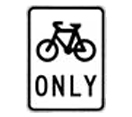
Bicycle only pathway
- Bicycle only pathways can be used by all bike riders, as well as wheeled recreational devices, e-bikes and personal mobile devices.
- Do not allow pedestrians.
Riding in malls and on roads
Bicycles, wheeled recreational devices, e-bikes and personal mobility devices are not permitted to be ridden in public squares and malls where a prohibition sign, such as a “No Bicycles” sign, is in place. This includes such areas as Reddacliff Place and the Queen Street Mall. People must dismount and walk through these areas.
Under the road rules, bicycles are considered vehicles and have the right to use the road just as cars do. This means that people riding bikes must also obey the road rules. In addition, bike riders should always travel with the flow of traffic when in a bicycle lane, unless otherwise signed for travel in both directions.
Personal mobility devices may also ride on roads in some circumstances and riders must behave in a manner similar to bicycles.
Visit the Department of Transport and Main Roads website to find out more about what road rules apply.
Riding safety tips
When riding be sure to:
- wear an Australian Standards approved helmet
- wear appropriate footwear, such as enclosed shoes
- stay hydrated
- obey all road rules (including when on bike paths)
- use reflectors, lights and bright clothing, especially at night or during rain.
Rider responsibility
Our roads and shared pathways are safer and more enjoyable when everyone obeys the rules and treat others with respect.
When riding remember to:
- slow down on crowded paths
- ride at appropriate speeds by slowing down when passing or overtaking
- sound your bell or let other people know that you are approaching
- keep as far left as possible
- be considerate of others
- ride in a predictable manner
- expect the unexpected
- create a safe and friendly environment by saying a quick 'hello' or 'thank you' when passing.
Riding signs
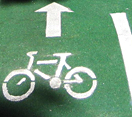
Bicycle lane (on-road bike riding facility)
Bicycle lanes are dedicated on-road bike riding facilities. The green surface improves bicycle awareness and traction for riders in wet conditions. The same road rules apply for on-road bike lanes without the green surface treatment.
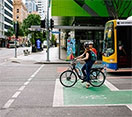
Bike rider boxes
A bike box (or bicycle storage area) is a section of the road for riders to wait at a red light in front of motor vehicles. The main purpose of a bike box is to provide a space where people riding a bike or personal mobility device are clearly seen by all users at intersections.
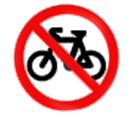
No bicycles
You cannot ride a bicycle, personal mobility device or other device beyond this point. You must dismount and walk with your bicycle or device.
This sign may appear on a sign or painted on the ground.
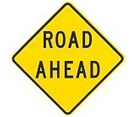
Road ahead
Bikeway crosses a road ahead. People riding bikes, personal mobility devices or other devices must give way to vehicles.
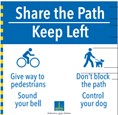
Shared pathway general information
This sign indicates the basic shared pathway etiquette including:
- all users to keep left
- people walking don’t block the path
- bike and e-scooter riders give way to people walking, and
- bike riders should notify people walking that they are approaching.
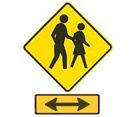
Pedestrian crossing ahead
This sign indicates that pedestrians are likely to be crossing the bike path ahead.